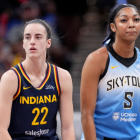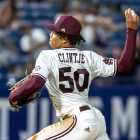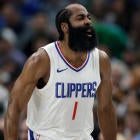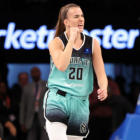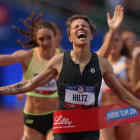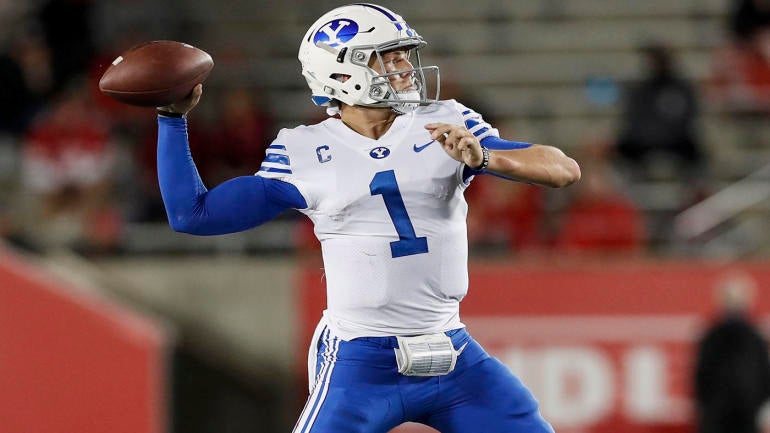
Three years ago, the New York Jets didn't think they'd be here. They'd just moved up from the No. 6 overall pick in the 2018 NFL Draft to the No. 3 slot, sending three second-round picks to the Indianapolis Colts in order to facilitate the swap.
With that third selection, they tabbed USC quarterback Sam Darnold, who they expected to lead the team into the future. Of course, things didn't work out exactly as planned. Darnold was hardly effective as a rookie, and arguably regressed in Years 2 and 3 under former head coach Adam Gase. Last week, the Jets traded him to the Carolina Panthers for draft considerations, kickstarting another rebuild for a franchise that has gone through a lot of them in recent years.
With nine picks in the upcoming draft, the Jets have a chance to put a significant imprint on their roster. Not only are they expected to land a new quarterback with the No. 2 overall pick, but they have more than enough ammo to surround him with better talent than they ever afforded Darnold. Here's how they can do it, in five (not-so-)simple steps.
Here's where you can purchase an officially licensed Jets NFL Draft hat and other Jets merchandise, some at 65% off.
1. Get your quarterback
No decision that Joe Douglas and Robert Saleh will make during their respective tenures with the Jets is more important than this one. New York knows Trevor Lawrence will be off the board after the Jaguars make him the first pick in the 2021 NFL Draft. That means the Jets can choose Zach Wilson, Justin Fields, Trey Lance, or Mac Jones to be their quarterback of the future.
Nearly every recent media report indicates Wilson will be their choice. He's the No. 2 overall prospect in our rankings here at CBS Sports, and the No. 2 quarterback (and No. 4 overall player) at both ESPN and The Athletic.
As a player, his skill set makes sense for new offensive coordinator Mike LaFleur's offense. Wilson has the mobility to make the play-action, bootleg system work at a high level, and he has the requisite accuracy on intermediate throws to take advantage of the openings the system creates. His improvisation ability will serve him well in the event the Jets don't use the draft to upgrade the offensive line in front of him, which still needs quite a bit of work to get to the point where it is a strength. And as they surround him with more and more playmakers, Wilson will be able to take advantage of that gift to create big plays rather than escape negative ones.
(While Wilson seems the likely pick, the Jets should be sure to do their requisite diligence on Fields, Lance, and Jones. They each have their own merits, and just because reports indicate one guy is the guy, doesn't mean he'll end up being the guy on draft day.)
2. Infrastructure week(end)
While some of the blame for the failure of the Sam Darnold era has to fall on the shoulders of Darnold himself, there is no denying that the Jets as an organization failed to put their former franchise quarterback in position to succeed. In three seasons as a starter, Darnold played behind offensive lines that ranked, on average, 27th in Pro Football Focus' pass-blocking grades and 26th in Football Outsiders' Adjusted Sack Rate. Not until last offseason did the Jets truly invest any significant resources in upgrading the line in front of Darnold.
The Jets also failed to give Darnold enough high-quality pass-catchers, and they failed to properly utilize the ones they did have. Robby Anderson had talent, but didn't get to fully showcase it until he left for Carolina. Chris Herndon has averaged just 3.1 targets per game in his three NFL seasons. Denzel Mims played only 44% of snaps. Breshad Perriman was scarcely targeted down the field. The list goes on.
The new Jets regime can't repeat those same mistakes. That's why they need to use at least a few of their nine picks in this draft to continue upgrading the infrastructure around the player they select at No. 2 overall. New York has four more Day 1 and Day 2 picks (No. 23, 34, 66, and 86); and while it's important that the Jets land a few defenders, they shouldn't forget that the best path to sustainable success is on the other side of the ball. Doing everything possible to put their quarterback in a good position has to be top of mind.
Even after drafting Mekhi Becton and signing George Fant, Connor McGovern, and Greg Van Roten last offseason, the offensive line still has to be considered a position of need. Landing a right tackle to complement Becton -- someone like USC's Alijah Vera-Tucker (who can also play guard), Oklahoma State's Teven Jenkins, Michigan's Jalen Mayfield, or Notre Dame's Liam Eichenberg, for example -- would be a good start, but they should also look for interior linemen later on in the draft. Tackles are generally harder to find on Day 3, but guards and centers can be plucked from the later rounds.
The Jets should also keep in mind that they'll have a need at wide receiver once Jamison Crowder moves on. His contract is up at the end of this season, and the team would actually save $10 million against the cap this year by releasing him. (It'd be valuable to do so because they could carry over that space to next year.) Looking for a slot-only guy like Crowder may not be necessary with Braxton Berrios on the roster, so they can open it up and look at some of the Day 2 wideouts like Minnesota's Rashod Bateman, LSU's Terrace Marshall, Purdue's Rondale Moore, Mississippi's Elijah Moore, and Florida's Kadarius Toney. If they want to wait until Day 3, some potential fits include North Carolina's Dyami Brown, Louisville's Tutu Atwell, and North Texas's Jaelon Darden.
LaFleur's Kyle Shanahan-style offense prioritizes run-after-catch ability, so they should take that into consideration. They might also want to take a look at a tight end who is a better blocker than Herndon, since that's an important part of the offense. And Tevin Coleman might have been brought in due to his familiarity with the system, but he's not a long-term answer in the backfield. Finding a one-cut, north-south runner with good speed to break big plays once he gets through the muck (like Mississippi State's Kylin Hill or Virginia Tech's Khalil Herbert, for example) should be in the cards on Day 3.
3. Take multiple shots in the secondary
Last season, the Jets were a disaster against the pass. Their opponents posted the fourth-best passer rating in the NFL, throwing 34 touchdowns against only 10 interceptions. As a result, the Jets ranked just 28th in pass defense efficiency, per Football Outsiders' DVOA.
So far this offseason, their most notable additions to the defensive back room are Justin Hardee and Lamarcus Joyner. Simply put, they need to continue adding bodies here. Marcus Maye is a budding star and Ashtyn Davis has some potential next to him, but they can't be expected to cover the back end alone. It would be advisable for the Jets to use two or three of their non-No. 2 picks on the cornerback position alone, and they could add a safety for depth, as well.
Corners with size and length like Georgia's Tyson Campbell and Eric Stokes and Syracuse's Ifeatu Melifonwu stand out as potential fits, but so do later-round prospects like Stanford's Paulson Adebo, Michigan's Ambry Thomas, and even 6-foot-4 South Carolina corner Israel Mukuamu, who would be a bit of a project but could have incredibly high upside if he hits.
4. Fortify the edge
Of course, pass defense isn't all about the secondary. And last year, the Jets came up short in the pass rush department as well. New York ranked 25th in pressure rate and 23rd in quarterback knockdown rate last season, per Pro Football Reference, indicating there is plenty of room for improvement on that front.
Of the players returning from last year's roster, only Quinnen Williams had more than 2.5 sacks. Signing Carl Lawson to a three-year deal is a good start, but he can't do it alone. Adding Sheldon Rankins to help Williams up the middle is a nice, low-cost flier, but Rankins is two years removed from his eight-sack 2018 season, and he totaled just 3.5 takedowns across 22 games in 2019 and 2020.
Edge rusher should be on the board for the Jets as early as their second pick of Round 1, when players like Georgia's Azeez Ojulari, Miami's Jaelen Phillips, and Michigan's Kwity Paye all make sense in terms of both value and their potential fit in Saleh's defensive scheme. If they decide to go in another direction with that second first-rounder, they'd be wise to grab an edge on Day 2, or to double-up on pass-rushers on Day 3. It all depends what, exactly, they're looking for. But much like wide receiver remains a quiet need despite the fact that the Jets signed Davis, so, too, does edge rusher despite the signing of Lawson.
5. Think beyond the 2021 season
See all those needs we detailed above? Offensive line and wide receiver and tight end and running back, plus the secondary and the defensive line? This is a team with a lot of holes. The Jets should keep that in mind as they go through the draft. Even with nine picks, they're unlikely to completely turn this team around in one offseason. Trading down or even out of some of their picks in favor of picking up additional assets remains a good idea.
The Jets still have $25 million in cap space this offseason (before signing their draft pool), and they'll be able to roll a decent chunk of that over to next year. They're already set to have around $71 million in cap room next season at the moment, per Over The Cap, and they also have two picks in the first, second, fifth, and sixth rounds of the 2022 draft. That's a nice stockpile of future assets around which they can build their team already, and they can add to it by moving around on Days 2 and 3 of the draft. With four picks in the top 84 this year, they can even make all of those selections and still have plenty left to acquire additional future capital with their extra fourth-, fifth-, and sixth-round picks.
The goal for the Jets shouldn't be to make the playoffs in 2021. It should be to build a sustainable winner that can compete for Super Bowls by Years 3, 4, and 5 of their new quarterback's rookie deal, and that still has the requisite salary cap and draft capital available after that to remain in contention in the future. They don't have to look much further than their own division (the Bills) to see how that plan can work when it's executed correctly. The Jets have the ammo to do something similar, and they should.










